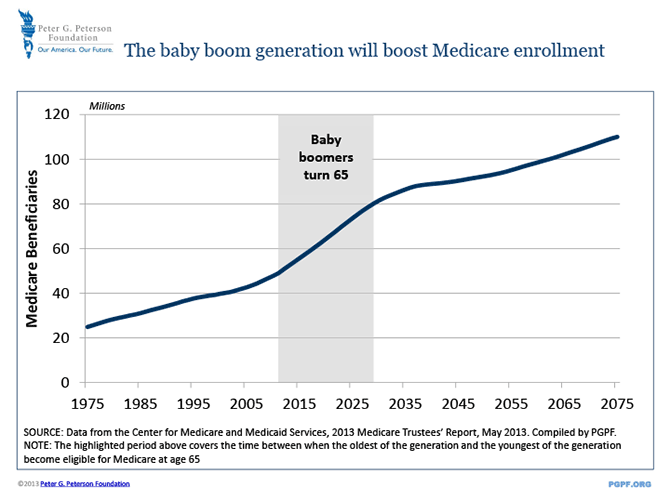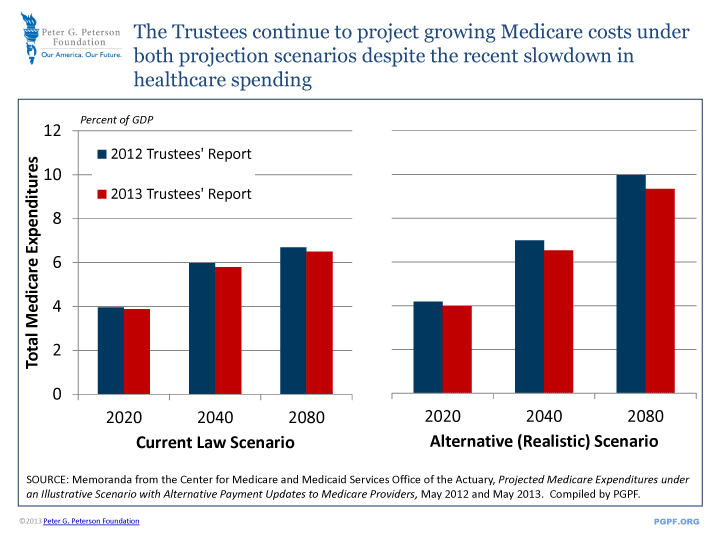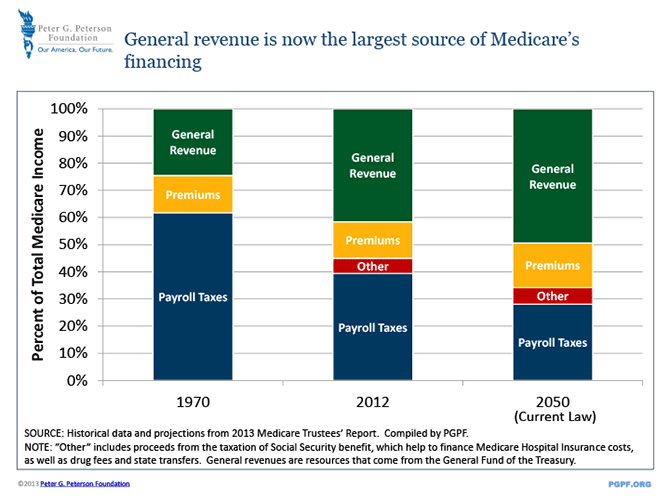You are here
The Medicare Trustees Report in Charts
The recently-released Medicare Trustees' Report warns that the program faces significant financial challenges in coming years.
Here are some highlights from this year's report:
- The Trustees expect the beneficiary population to grow by one-third in the coming decade as the baby boom generation becomes eligible for benefits.
- The Medicare Hospital Insurance (HI) Trust Fund will run out of money to pay full benefits in 2026, only two years later than projected in last year's report despite the recent slowdown in healthcare spending.1
- The Trustees predict that overall Medicare costs will grow by between 60 and 80 percent in the next three decades, depending on how closely policymakers adhere to cost reductions scheduled under current law.
Some commentators herald the recent slowdown of system-wide healthcare cost growth and claim that we can put Medicare reform on the back burner. The Trustees themselves dispute that view; the recent slowdown has led to only modest revisions to their outlook. They warn that Congress and the Administration should work "with a sense of urgency" to put the program on a sustainable path. "If lawmakers take action sooner rather than later, more options and more time will be available to phase in changes so that the public has adequate time to prepare. Earlier action will also help elected officials minimize adverse impacts on vulnerable populations, including lower-income workers and people already dependent on program benefits."
Growing enrollment
Enrollment in Medicare will increase rapidly over the next two decades. The increase stems from two demographic factors. First, the baby boom generation will become eligible for Medicare benefits as they turn 65. In addition, Americans are living longer. A 65-year old man today is expected to live to 83, compared to 78 in 1966, when the first beneficiaries enrolled in the program. As a result of both of these factors, Medicare enrollment will increase by more than 70 percent between 2010 and 2030.

Rising spending
Growing enrollment and rising healthcare costs will put increasing pressure on Medicare spending. Under current law, the Trustees project Medicare's costs to grow from 3.6 percent of GDP in 2012 to 5.8 percent of GDP in 2040. By 2087, Medicare costs would reach 6.5 percent of GDP.
But the Trustees warn that costs could be even higher, predicting that "the actual future costs for Medicare are likely to exceed those shown by the current-law projections in this report, possibly by substantial amounts." These current-law projections assume that various cost-reduction measures will materialize as required in the Affordable Care Act (ACA) and that physician payment rates will be cut by 25 percent in 2014 — both of which will not necessarily occur. To reflect this uncertainty, the report also includes an Alternative Scenario to project a more realistic outcome.
Medicare spending is projected rise sharply under the Trustees' two policy scenarios
Percentage of GDP
| Medicare expenditures | |||
|---|---|---|---|
|
|
2012 | 2040 | 2087 |
|
Current Law
|
3.6 | 5.8 | 6.5 |
|
Alternative (Realistic) Scenario
|
3.6 | 6.5 | 9.8 |
SOURCE: Data from the Center for Medicare and Medicaid Services, 2013 Medicare Trustees’ Report, May 2013. Compiled by PGPF.
NOTE: Current law assumes that physician payment rates will drop by 25 percent in 2014 and that ACA will significantly reduce Medicare expenditures. The realistic scenario assumes that payment rates will not be reduced and that the ACA will be less successful in controlling costs.
If lawmakers override the reduction in physician rates in 2014 and the ACA's cost-reduction measures, the Trustees project Medicare spending would soar from 3.6 percent of GDP in 2012 to 9.8 percent of GDP in 2087, an increase of 172 percent. The Trustees emphasize that "growth of this magnitude, if realized, would substantially increase the strain on the nation’s workers, the economy, Medicare beneficiaries, and the Federal budget."
Many commentators have trumpeted the fact that the growth of healthcare costs has slowed. Although the Trustees incorporated this new information into their latest projections, their revisions have been quite modest. This year's report shows that Medicare's HI Trust Fund will be exhausted in 2026 — only two years later than estimated last year.2

Despite the slowdown, Medicare costs continue to rise sharply over the projection period under both current-law and the alternative (realistic) scenario.
Medicare Financing
For the seventh consecutive year, the Trustees issued a statutory “Medicare funding warning” indicating that financial transfers from federal general revenues are covering a substantial share of the program's total costs. The warning highlights the fact that payroll taxes and beneficiary premiums cover only a portion of Medicare costs despite a widespread belief to the contrary. In truth, the program is heavily subsidized with general revenues, which accounted for nearly 42 percent of program financing in 2012. The Trustees project the share of general revenue funding to will grow to 49 percent in 2050.

Conclusion
The Medicare Trustees’ Report once again depicts a financially troubled program that will be unable to sustain services unless changes are made. Although this year's projections reflect the slight slowdown in healthcare cost growth in the last few years, Medicare spending is still projected to grow by 60 to 80 percent over the next three decades.
The Trustees' Report calls for Congress and the administration to act with a sense of urgency to address the growth in total Medicare expenditures and the exhaustion of the HI Trust Fund. If legislative action is taken soon, program reforms can be more gradual, giving both beneficiaries and taxpayers time to prepare for changes. Conversely, every year of inaction increases the severity of the changes that policymakers will eventually be forced to make to Medicare, increasing the adverse impact on those who are dependent on the program’s benefits.
1The Medicare Hospital Insurance (HI) Trust Fund is financed largely through payroll taxes and covers Medicare Part A hospital insurance. Parts B (Supplementary Medical Insurance) and Part D (prescription drug coverage) are financed through a combination of general revenues and premiums paid by beneficiaries. Part C, or Medicare Advantage, is not separately financed; it is managed care approach to provide the same benefits that are separately offered under Parts A, Part B, and Part D.
2 There is no insolvency date for Medicare Parts B and D because general revenues fill in any gap between cost and program revenues.
